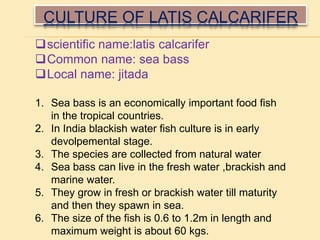
Culture of latis calcarifer.pptx
- 1. CULTURE OF LATIS CALCARIFER scientific name:latis calcarifer Common name: sea bass Local name: jitada 1. Sea bass is an economically important food fish in the tropical countries. 2. In India blackish water fish culture is in early devolpemental stage. 3. The species are collected from natural water 4. Sea bass can live in the fresh water ,brackish and marine water. 5. They grow in fresh or brackish water till maturity and then they spawn in sea. 6. The size of the fish is 0.6 to 1.2m in length and maximum weight is about 60 kgs.
- 2. FEEDING HABITS 1. juveniles are omnivores while adult is voracious carnivores. 2. stomach content of wild species show crustaceans ,algae, small shrips and small fishes as well.
- 3. CULTURE TECHINQUE 1)NURSERY CULTURE 2)GROW OUT CULTURE 3)POND CULTURE
- 4. NURSERY CULTUERE 1) Main purpose of this is to culture fishery from (1 to 2.5 cm ) to juvenile size i.e upto 10cm. 2) After that depending upon the size, juveniles are seperated. 3) Concrete tanks are not recommended because the excess food material settels at the bottom leads to bacterial growth .
- 5. POND PREPARATION • In this pond is completely dried till bottom and immeadiatly filled with water. • It is totally dependant on supplemental food . • To enhance the production, the precautions were take such as the nursery pond must be completely drained and dried until the bottom soil craks to release toxic gas to eradicted insect pest and predators. • If unwanted species are not completely eradicate, mixture of ammonium sulphate with lime in ratio 1:50 is soaked (50kgs hecter) • In the pond plankton is added which is favourite food of fish. Nursery Pond management 1. Sea bass can be culture in either in freshwater or in salt water 2. During transport the salinity and tempreture is maintained. 3. Sea bass fry are stocked in nursery , pond at density of 20 to 50 per metre square. 4. 30% of water in the pond should be change daily, deteoriation of water quality due to decomposition of uneaten food.
- 6. GROW OUT CULTURE 1. It is a phase which involves growing of sea bass from juveniles to markatable size. 2. Normally accepted markatable size of the fish varies between countries to countries but it ranges fom 300gm to 1 kg 3. The feeding contains chopped trash fish twice daily and it should be given when the fish swim on the surface.
- 7. POND CULTURE There are two methods of pondculture a) Monoculture b) polyculture a) In monoculture , single species is cultivated. Fishes are dependant on suplementary food which is trash fish,soybean milk,vitamin and rice bran b) In polyculture,along with the sea bass,other fishes are also cultivated which will help to reduce the amount of uneaten food by sea bass and will not harm the same.
- 8. CRITERIA FOR SITE SELECTION PH = 7.5 to 8.5 D.O = 4 TO 9 ppm SALINITY = 10 T0 30 ppt TEMPRETURE = 26 TO 32 AMMONIA = less than 1 ppm TURBIDITY = less than 10 ppm Soil should have enough clay content for holdings water in pond upto 40% of clay is best.